

Science. In Search of Myths and Heroes. Watch the four myths that inspired Michael Wood to embark on his journey: The Queen of Sheba, the earthly paradise of Shangri-La, King Arthur and Jason and the Argonauts.
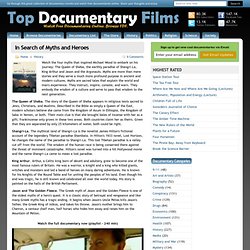
Myths are more than mere stories and they serve a much more profound purpose in ancient and modern cultures. Myths are sacred tales that explain the world and man's experience. They instruct, inspire, console, and warn. They embody the wisdom of a culture and serve to pass that wisdom to the next generation. What Happened Before the Beginning? Every cosmologist and astronomer agrees: our Universe is 13.7 billion years old.
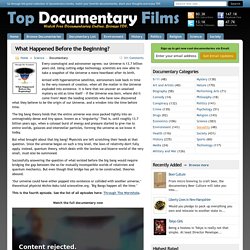
Using cutting-edge technology, scientists are now able to take a snapshot of the Universe a mere heartbeat after its birth. Armed with hypersensitive satellites, astronomers look back in time to the very moment of creation, when all the matter in the Universe exploded into existence. It is here that we uncover an unsolved mystery as old as time itself - if the Universe was born, where did it come from?
SECURITY ENGINEER - SilverSky. Monsters We Met. The first humans left their African homeland 100,000 years ago and began an epic journey that was to end with mankind dominating the globe.
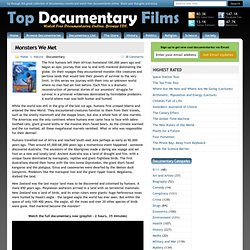
On their voyages they encountered monster-like creatures and perilous lands that would test their powers of survival to the very limit. In this series we journey with them into an unknown world where no man had set foot before. Each film is a dramatic reconstruction of personal stories of our ancestors’ struggle for survival in a primeval wilderness dominated by formidable predators. A world where man was both hunter and hunted. Birth of the Earth. The Monkey-Eating Eagle of the Orinoco.
The Human Family Tree. Secrets of The Mind. In Secrets of the Mind we gain insights through various tragedies that have affected others, thanks to the logic and insights of Professor Ramachandran regarding what he calls the most complex organized matter in the universe.
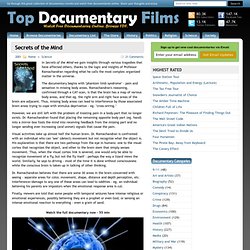
The documentary begins with "phantom limb syndrome" - pain and sensation in missing body areas. Ramachandran's reasoning, confirmed through a CAT-scan, is that the brain has a map of various body areas, and that eg. the right arm and right face areas of the brain are adjacent. Thus, missing body areas can lead to interference by those associated brain areas trying to cope with stimulus deprivation - eg.
"cross-wiring. " However, we are still left with the problem of treating pain in a body-part that no longer exists. Visual activities take up almost half the human brain. Dr. Violent Universe. What Is Reality? Secrets of the Parthenon. A highly sophisticated restoration team is painstakingly reassembling the Parthenon of Athens—a classic Greek building that has suffered from wars, earthquakes, and disastrous previous restoration attempts.

The Parthenon's builders created dauntingly precise yet subtle curves throughout the structure, giving the building its legendary grace. Etched in the marble itself, the restoration team discovers traces made by the ingenious tools the stonemasons used to carve the blocks with such speed and precision. Experts examine the extent to which the Parthenon's symmetry and visual harmony is dependent on a system of mathematical proportions.
Two hundred miles from Athens, faint lines left behind on another Greek temple reveal the technique the early engineers used to sculpt the Parthenon's perfect curves. (Excerpt from pbs.org) What The Ancients Did For Us: The Indians. India is one of the oldest and richest civilizations in the world.
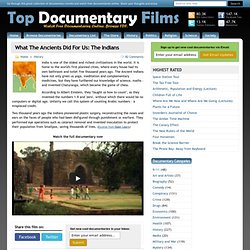
It is home to the world's first planned cities, where every house had its own bathroom and toilet five thousand years ago. The Ancient Indians have not only given us yoga, meditation and complementary medicines, but they have furthered our knowledge of science, maths - and invented Chaturanga, which became the game of chess. According to Albert Einstein, they "taught us how to count", as they invented the numbers 1-9 and 'zero', without which there would be no computers or digital age.
Unfairly we call this system of counting Arabic numbers - a misplaced credit. Break the Science Barrier. Quants: The Alchemists of Wall Street. The Day The Earth Nearly Died. 250 million years ago, long before dinosaurs roamed the Earth, the land and oceans teemed with life.

This was the Permian, a golden era of biodiversity that was about to come to a crashing end. Within just a few thousand years, 95% of the lifeforms on the planet would be wiped out, in the biggest mass extinction Earth has ever known. What natural disaster could kill on such a massive scale? It is only in recent years that evidence has begun to emerge from rocks in Antarctica, Siberia and Greenland. HOME. Do You Know What Time It Is? Particle physicist Professor Brian Cox asks, 'What time is it?
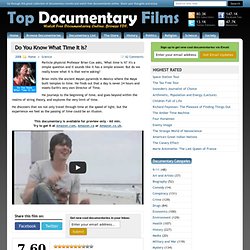
' It's a simple question and it sounds like it has a simple answer. Known Universe: The Fastest. What is the Higgs Boson? Scientists behind Sixty Symbols (Ed Copeland, Roger Bowley and Tony Padilla from the University of Nottingham) are doing their best to answer what actually is the Higgs Boson.
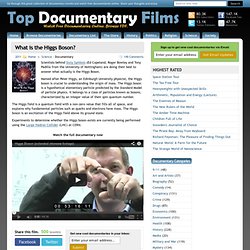
Named after Peter Higgs, an Edinburgh University physicist, the Higgs boson is crucial to understanding the origin of mass. The Higgs boson is a hypothetical elementary particle predicted by the Standard Model of particle physics. It belongs to a class of particles known as bosons, characterized by an integer value of their spin quantum number. Learning to Think Critically. From the author: Despite great strides in our understanding, the average person still does not understand science in the facts or in the practice, and instead fills the void with pseudoscience.
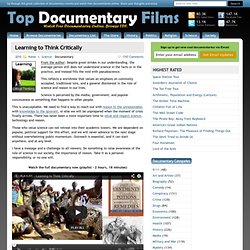
This reflects a worldview that values an emphasis on commonly accepted, traditional lore, and a general disinterest in the role of science and reason in our lives. Science is perceived by the media, government, and popular conciousness as something that happens to other people. This is unacceptable. We need to find a way to reach out with reason to the unreasonable, with knowledge to the ignorant, or else we will be unprepared when the moment of crisis finally arrives. Reality and the Extended Mind. Extinctions. More than 90 percent of all organisms that have ever lived on Earth are extinct.
As new species evolve to fit ever changing ecological niches, older species fade away. The Chemistry of Almost Everything. Chemistry is involved in everything and is everywhere. This series explains how some of the processes work. Professor Steven Ley from Cambridge University discusses the development of a molecule in his research lab. Seven Wonders of the Microbe World. This little documentary is talking about Microbes and why some are good, some are bad and what they have done for mankind. Microbes have given us some devastating diseases, everything from the Black Death to cholera, syphilis, typhoid and the occasional yeast infection.
But our microbial friends have also done us some good. What Darwin Never Knew. Earth teems with a staggering variety of animals, including 9,000 kinds of birds, 28,000 types of fish, and more than 350,000 species of beetles alone. What explains this explosion of living creatures-1.4 million different species discovered so far, with perhaps another 50 million more to go? The source of life's endless forms was a profound mystery until Charles Darwin's revolutionary idea of natural selection, which he showed could help explain the gradual development of life on earth. But Darwin's radical insights raised as many questions as they answered. Hyperspace. If the scholarly tone and historical depth of Cosmos made that science miniseries akin to National Geographic magazine, then Hyperspace is like the National Enquirer. Can You Hack It? – Hackers Wanted. Cosmic Voyage. Einstein’s Unfinished Symphony. As Albert Einstein lay on his deathbed, he asked only for his glasses, his writing implements and his latest equations.
He knew he was dying, yet he continued his work. In those final hours of his life, while fading in and out of consciousness, he was working on what he hoped would be his greatest work of all. It was a project of monumental complexity. It was a project that he hoped would unlock the mind of God. "I am not interested in this phenomenon or that phenomenon," Einstein had said earlier in his life. It was a journey that started 50 years earlier in Berne, Switzerland. Cosmic Journeys. Richard Feynman: The Character of Physical Law. Strange Days on Planet Earth.